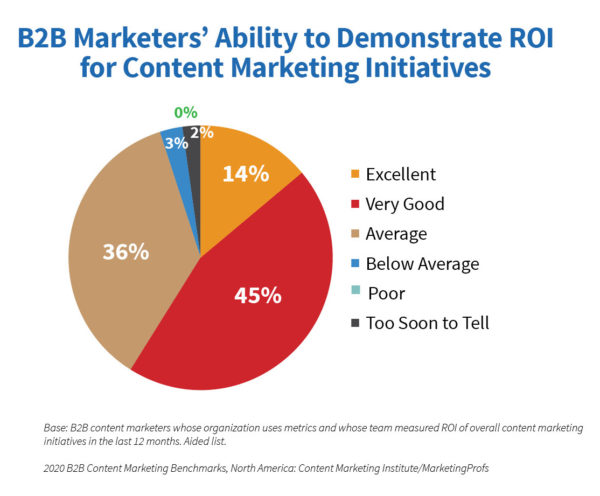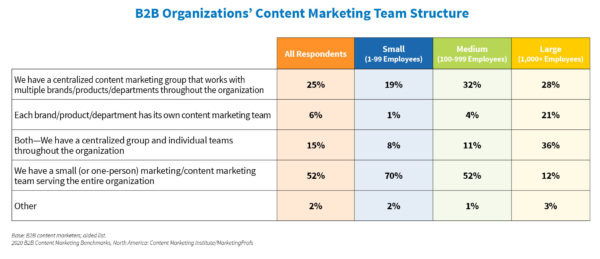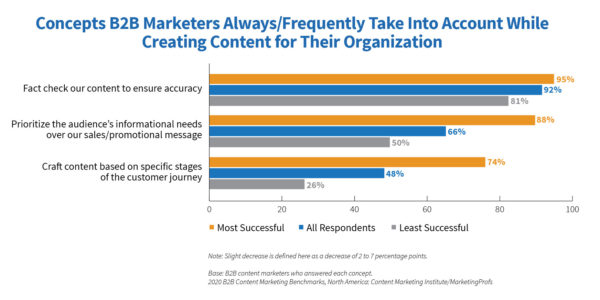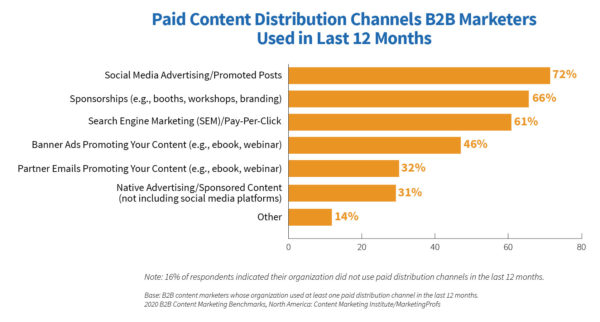Most B2B marketers use content marketing effectively to achieve top-of-the-funnel goals like brand awareness and audience education. But they are missing out on opportunities deeper in the funnel.
This is just one of the key findings from the newly released 2020 B2B Benchmarks, Budgets, and Trends – North America from Content Marketing Institute and MarketingProfs, and sponsored by Sitecore.
The three most-cited content marketing goals achieved in the last 12 months were:
- Creating brand awareness (86%)
- Educating audience(s) (79%)
- Building credibility/trust (75%)
However, fewer B2B marketers say their efforts delivered success against goals like:
- Building subscribed audiences (45%)
- Generating sales/revenue (53%)
- Building loyalty with existing clients/customers (63%)
Only 45% of #B2B marketers achieve the goal to build subscribed audiences. @CMIContent #research Click To Tweet
What do the three latter goals have in common? They focus on growing more lasting relationships with audiences (both customers and non-customers) and delivering bottom-line results.
And that’s the biggest differentiator for those B2B marketers who characterize their organizations as extremely or very successful with content marketing (“top performers”). They are far more likely (to the tune of 21 to 23 percentage points higher) to achieve these three relationship goals with their content efforts when compared with all surveyed B2B marketers.
Getting attention is great, but marketers must keep that attention. Kudos to those who are creating lasting impressions and super fans. Continue that great work
For the rest, it’s time to focus, to look for inspiration from brands doing it right, and to think about long-term relationships. If you don’t, content consumers are all-too-ready to swipe left.
Click to enlarge
This isn’t to say that B2B marketers aren’t making progress with using content marketing to nurture subscribers, audiences, and leads. In the 2019 research, 58% said they were achieving this goal successfully, compared with 68% of all respondents for 2020.
(To learn how content is being used to pursue all marketing goals, including awareness, lead gen, conversions, etc., read the more detailed report.)
The 2020 study also dives into detail on other issues of critical importance to B2B marketers and their content marketing programs, such as:
- Highest performing content by types and goals
- Concepts around content creation, from the sales funnel to fact-checking
- Organic and paid content distribution channels, including social media platforms
- Content marketing organizational structures, from teams to budget
- Content marketing outsourcing
- Technology
- Metrics, KPI, and ROI
New 2020 #B2B #research reveals findings from goals & preferred channels to outsourcing & tech via @CMIContent. Click To Tweet
As a whole, this year’s B2B research provides valuable insights you can use to gauge your efforts vs. your peers and make the case to stakeholders. To help identify your best opportunities, let’s look at several key differences between the top performers and the group as a whole.
How content marketers organize to get the work done
The research examined key issues about how content marketing functions within the organization and the size of today’s content marketing teams.
While 25% of all B2B marketers say they operate as a centralized content marketing group that works throughout the organization, 44% of the top performers use that centralized structure. While the number of team members grows by company size, even large companies are most likely to have teams of two to five (49%).
The most successful set, document, and maintain a content marketing strategy. They don’t simply crank out content for anyone and everyone around the organization but establish a cohesive plan for creating and distributing content that meets the brand’s mission and caters to audience needs.
Click to enlarge
Noteworthy finding: Almost one-third of respondents (32%) lack a full-time person dedicated to content marketing, while this number drops to 13% when looking only at the top performers.
32% of B2B marketers don’t have a full-time person for #contentmarketing via @cmicontent. #research Click To Tweet
Additionally, 50% of all respondents outsource at least some of their content marketing, with content creation topping the list of outsourced content marketing activities for all respondents (84%). We didn’t observe any notable differences here between all respondents and the top performers.
Our advice: Find content creators who understand what’s unique about your company, know how to rise above the mediocre, and amaze your audience with their writing, researching, video, or audio skills.
HANDPICKED RELATED CONTENT:
Get content priorities right
Does your organization prioritize delivering relevant content when and where a person is most likely to see it? Most (93%) of the top content marketing performers do. Yet, the number drops to 71% when looking at all programs regardless of their success.
We also noted important differences in other audience-focused questions. For example:
- Only two-thirds (66%) of content marketing programs prioritize their audience’s informational needs over their organization’s sales/promotional message. Yet, 88% of the top performers do.
88% of top #contentmarketing performers put audience needs over their sales messages. @cmicontent #research Click To Tweet
- Top content marketing performers are more likely to always or frequently craft content based on the stages of the customer journey (74%), while that rate dips to less than half (48%) when looking at all respondents.
The lesson here: Stay true to your audience’s needs. It’s time to push back on execs who ask for salesy messaging vs. educational content unless you are focused on the bottom of the funnel. No consumer ever said, “I don’t get enough pitchy product news.”
It’s time to push back on execs who ask for salesy #content unless you’re focused on bottom of funnel. @EditorStahl Click To Tweet
Click to enlarge
HANDPICKED RELATED CONTENT:
Go outside your owned media
Most marketers – no matter how successful their content marketing program is – use email, their website/blog, and their social channels to distribute their content organically. But the top performers are more likely to amplify their content using non-owned channels, such as:
- Media/influencer relations (46% of top performers vs. 34% of all)
- Guest posts/articles in third-party publications (63% vs. 48%)
- Speaking/events (70% vs. 63%)
Top #B2B performers are more likely to use non-owned channels to distribute #content. @CMIContent #research Click To Tweet
Click to enlarge
The research also revealed that 84% of respondents have used paid distribution channels in the last 12 months (91% among the top performers). Among those who use paid methods, 72% said they’ve used paid social (75% of top performers in this group did).
84% of #B2B #content marketers use paid distribution channels, according to @cmicontent 2020 #research. Click To Tweet
Click to enlarge
To learn more about what the B2B marketers had to say about distribution channels, including a breakdown by social media platform, and which generated the best results, read the detailed report.
HANDPICKED RELATED CONTENT:
Check on the results
How can you know if your content marketing program is working? You better measure it – and evaluate your results regularly to gauge how well it’s delivering against your content marketing and brand goals.
While 80% of all respondents use metrics to evaluate content performance, almost all (95%) of the top performers do.
How do their content marketing goals tie to the business? Only 43% of B2B marketers say they measure ROI and 65% have established key performance indicators (KPIs), while 67% of the top performers evaluate ROI and 83% monitor KPIs.
Only 43% of #B2B marketers say they measure #contentmarketing #ROI via @cmicontent. #research Click To Tweet
It was encouraging to see that of the 43% who do measure, 59% of all respondents (and 84% of the top performers) say they are doing an excellent or very good job of demonstrating ROI. Showing ROI is a difficult undertaking, but this finding suggests a solid portion of content marketers are nailing the process. For those who aren’t … well, what are you waiting for?

HANDPICKED RELATED CONTENT:
What’s next
We asked a new question this year about providing customers with optimal experiences across the engagement journey – 52% of respondents agree that they are. That stat reflects that our work is cut out for us, content marketers.
As you read through this year’s B2B results and interpret how they might affect your current content marketing approach – and how you set your priorities for the upcoming year – CMI’s Chief Strategy Advisor Robert Rose offers this advice:
You have to stop thinking of content marketing as the thing that’s only worth investing in if it creates a lead or an opportunity. Instead, think about how to AMAZE your audiences. Treat your audiences as customers because that is the way you can lean into data acquisition and personalize your experiences.
Here’s to a successful 2020.
Download the full report: 2020 B2B Benchmarks, Budgets, and Trends – North America from Content Marketing Institute and MarketingProfs.
HANDPICKED RELATED CONTENT:
Be among the first to get the 2020 research for B2C as well as other industry reports. Subscribe today to the free weekday CMI newsletter.
Cover image by Joseph Kalinowski/Content Marketing Institute






